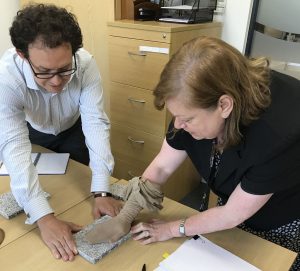The preparations for our upcoming refurbishment project involve considering lots of different strands of work, one of which relates to Rochester Esplanade.
As regular readers will know, the Trust owns the end of Rochester Esplanade nearest the bridges. We are still developing our designs to improve the area opposite the Bridge Chamber, adding benches and other changes, and a lot of time and effort is being put into its aesthetic appearance. However, for now we’re not looking at the designs but the materials.
Ilona, the Contracts and Project Manager; Rob, Deputy Lead Structural Engineer, from Bridge Engineer Arcadis; and Ben, Associate Technical Director, Arcadis; recently met by the balustrade on the Esplanade to assess samples of granite. Their aim was to find the closest match to the existing material, to be used for new features being designed for the area.
As well as taking in the obvious considerations of availability and cost, they also looked at density, compressive strength (how it copes with being squashed), flexural strength (how it bends), relative grain size, grain colour and colour tint. In simple terms, the last three relate to how the granite looks: will it fit in with what is already in place? Or will it stand out as being obviously new and different? The easiest way to answer those questions was to put samples next to the balustrade to compare. This is the result:
As you can see, some samples matched more closely than others.
 Back in the office, Bridge Clerk Sue and Lead Structural Engineer Tim joined in with further tests to ensure the best possible finish for the granite was selected with, among other things, a ‘bobbly-ness’ evaluation.
Back in the office, Bridge Clerk Sue and Lead Structural Engineer Tim joined in with further tests to ensure the best possible finish for the granite was selected with, among other things, a ‘bobbly-ness’ evaluation.
This was all part of the human element of the decision. The look and quality may add up, but how well can people interact with the material?
First we tested comfort. We put the samples onto a chair and sat on them.
Next came slip resistance – we want to do what we can to ensure a child (or adult) doesn’t slip over in the rain. This saw the person from the Trust’s staff who was wearing the most unsuitable shoes (we aren’t going to name and shame) standing on samples that had been doused in water. Don’t worry, we took the appropriate health and safety measures to protect them from falling!
Finally, the ‘bobbly-ness’ test. What impact will sitting on the granite have on your clothes? This isn’t an obvious test to do, but it’s one of the reasons a diverse workforce can be invaluable for bringing new ideas to a project. An emergency pair of tights was liberated from a desk drawer and the testing began by running the tights across the surface of the stone.
This simple test meant we were able to swiftly reject one of the favoured finishes and hopefully protect the posteriors of visitors to what we hope will become a pleasant area to sit and watch the river.

 Should you be wondering, the three types of finish that underwent these interaction tests were bush hammered, sandblasted and flamed.
Should you be wondering, the three types of finish that underwent these interaction tests were bush hammered, sandblasted and flamed.
Flamed, which sees the stone subjected to an intense heat that causes some of the quartz to split and chip, has a good surface variation to prevent slipping but fared the worst in the tights test.
Sandblasted – repeatedly blasting silica sand against the granite to make small craters that highlight the colour of the stone – looked smart enough but didn’t excel in any of our interactions.
Bush hammered ended up being our finish of choice. For this a masonry tool called a bush hammer is used to produce a generally uniform distribution of craters of different sizes over the surface of the stone. It did well in all three interaction tests and – while we know we can’t make everyone happy – we hope the ladies and gentlemen of Rochester and Strood will be able to enjoy the view safe in the knowledge their clothing won’t be snagged!
We’ll tell you more about the designs for Rochester Esplanade as our preparations progress.







